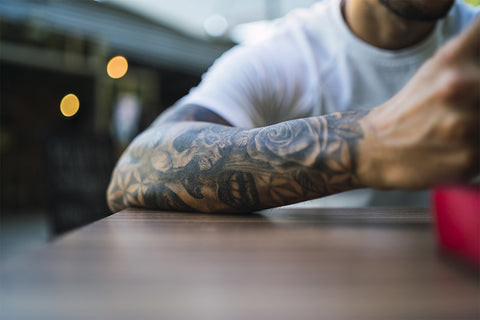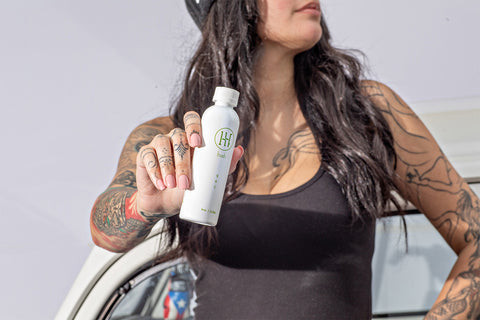Is A Forearm Tattoo Painful? Yes, but the level of discomfort is generally considered mild to moderate, especially compared to other body parts, and there are ways to minimize any pain and irritation with products from tattooat.com. Whether you’re a first-timer or adding to your collection, understanding the pain factor and how to manage it can help you achieve the amazing body art you envision, all while ensuring a more comfortable and enjoyable experience, that will include tattoo aftercare, pain management, and tattoo placement.
1. Understanding Forearm Tattoo Pain
While pain tolerance is subjective, forearm tattoos are often cited as being among the least painful locations to get inked, but how much pain you experience hinges on a few factors. Let’s delve into the specifics.
1.1. Inner vs. Outer Forearm
The outer forearm, with its thicker skin and fewer nerve endings, typically registers lower on the pain scale, as this area is more fleshy and muscular. Conversely, the inner forearm tends to be more sensitive because the skin is thinner and there are more nerve endings, however, even with the added sensitivity, many still consider the pain very manageable.
1.2. Proximity to the Elbow
Whether it’s the inner or outer forearm, the closer you get to the elbow, the more intense the sensation can become, as the skin around the elbow is thin and lies directly over bone, and this area is also full of nerve endings. You can use HUSH products to address the pain around the elbow to get your dream tattoo.
1.3. Individual Pain Tolerance
Everyone experiences pain differently, so what might be a breeze for one person could be more challenging for another, according to research from Portland State University’s Art Department. Your personal pain threshold, mental state, and even your physical health on the day of your appointment can all play a role in how you perceive the pain.
 Forearm tattoo pain depends on individual tolerance, but generally considered manageable.
Forearm tattoo pain depends on individual tolerance, but generally considered manageable.
2. Factors Influencing Tattoo Pain
Beyond location, several other factors can influence the level of pain you experience during a tattoo session. Knowing these can help you prepare and potentially mitigate discomfort.
2.1. Tattoo Size and Design Complexity
Larger, more intricate designs naturally take longer to complete, which means more time under the needle. The longer the session, the more fatigued your skin becomes, potentially leading to increased sensitivity.
2.2. The Artist’s Skill and Technique
An experienced tattoo artist with a steady hand and refined technique can make a world of difference. They’ll know how to work efficiently and minimize trauma to the skin, resulting in a less painful experience.
2.3. Your Mental and Physical State
If you’re tired, stressed, or anxious, you’re likely to be more sensitive to pain. Conversely, if you’re well-rested, relaxed, and have prepared yourself mentally, you’ll be better equipped to handle the discomfort.
2.4. Use of Numbing Agents
Topical anesthetics like lidocaine, found in products like HUSH Numbing Gel and Cream, can significantly reduce pain by blocking nerve signals in the treated area.
3. Popular Forearm Tattoo Designs and Their Impact on Pain
The type of design you choose can also play a role in how painful the tattoo process is. Here are a few popular forearm tattoo styles and what to expect in terms of pain:
3.1. Simple Line Work
Tattoos with fine lines and minimal shading tend to be less painful than those with heavy shading or bold colors, as they require less time and trauma to the skin.
3.2. Shading and Color Packing
Shading and color packing involve repeatedly going over the same area of skin, which can be more painful than simple line work.
3.3. Dot Work Tattoos
Dot work, which involves creating an image using thousands of tiny dots, can be time-consuming and may cause a prickly, stinging sensation.
3.4. Geometric Designs
Geometric patterns often involve straight lines and precise angles, which can be more painful in areas where the skin is thinner or closer to the bone.
3.5. Sleeve Tattoos
A sleeve tattoo, which covers the entire forearm, is a marathon of tattooing. Expect multiple sessions and varying levels of pain, as the needlework extends over a larger surface area with varying levels of nerve sensitivity.
4. Preparing for Your Forearm Tattoo
Proper preparation is key to a more comfortable tattoo experience. Here are some essential steps to take before your appointment.
4.1. Choose a Reputable Artist and Studio
Research local tattoo artists and studios, read reviews, and check out their portfolios to ensure they have the experience and skill to create the tattoo you want. A clean, professional environment is also crucial for preventing infections. Tattooat.com can help you find reputable artists and studios in your area.
4.2. Get a Good Night’s Sleep
Being well-rested will help you better manage pain and discomfort.
4.3. Stay Hydrated
Drink plenty of water in the days leading up to your appointment to keep your skin hydrated and supple.
4.4. Eat a Meal Beforehand
Having a full stomach will help regulate your blood sugar levels and prevent dizziness or lightheadedness during the tattoo session.
4.5. Avoid Alcohol and Blood Thinners
Alcohol and blood thinners can increase bleeding and sensitivity, so avoid them for at least 24 hours before your appointment.
4.6. Dress Comfortably
Wear loose, comfortable clothing that allows easy access to your forearm.
4.7. Consider Numbing Agents
Talk to your artist about using a topical anesthetic like HUSH Numbing Gel or Cream to minimize pain during the session.
5. Managing Pain During the Tattoo Session
Even with proper preparation, you may still experience some discomfort during your tattoo session. Here are some strategies for managing pain in the moment:
5.1. Focus on Your Breathing
Deep, slow breaths can help you relax and reduce tension.
5.2. Listen to Music or Podcasts
Distract yourself by listening to your favorite tunes or an engaging podcast.
5.3. Communicate with Your Artist
Don’t hesitate to let your artist know if you need a break or if the pain becomes too intense.
5.4. Squeeze a Stress Ball
Having something to squeeze can help release tension and distract you from the pain.
5.5. Visualize a Positive Outcome
Focus on the beautiful tattoo you’re going to have and how much you’ll love it.
6. Forearm Tattoo Aftercare: Ensuring Proper Healing
Proper aftercare is essential for preventing infections, promoting healing, and preserving the vibrancy of your tattoo. Here are some key steps to follow:
6.1. Keep the Area Clean
Gently wash your tattoo with mild, fragrance-free soap and water 2-3 times a day. Avoid harsh soaps or scrubbing, which can irritate the skin. HUSH CBD Foam Soap is specifically designed for tattoos and contains soothing botanicals to aid in healing.
6.2. Apply a Tattoo-Friendly Balm
After washing, pat your tattoo dry with a clean paper towel and apply a thin layer of tattoo balm or ointment. HUSH Healing Balm is a great option, as it contains CBD and moisturizing ingredients to soothe and protect your skin.
6.3. Avoid Sun Exposure
Sunlight can cause your tattoo to fade and can also damage healing skin. Keep your tattoo covered with clothing or apply a broad-spectrum sunscreen with zinc oxide after it has fully healed.
6.4. Don’t Pick or Scratch
As your tattoo heals, it will likely scab and itch. Avoid picking or scratching, as this can damage the ink and increase the risk of infection.
6.5. Stay Hydrated
Drinking plenty of water will help keep your skin hydrated and promote healing from the inside out.
6.6. Avoid Soaking
Avoid swimming, hot tubs, and long baths until your tattoo is fully healed, as soaking can increase the risk of infection.
6.7. Wear Loose Clothing
Wear loose, breathable clothing to avoid irritating your tattoo.
6.8. Follow Your Artist’s Instructions
Your tattoo artist will provide you with specific aftercare instructions based on your skin type and the type of tattoo you got. Follow their instructions carefully.
7. Long-Term Tattoo Care
Once your tattoo is fully healed, there are still steps you can take to keep it looking its best for years to come:
7.1. Stay Hydrated
Drinking plenty of water will keep your skin healthy and hydrated, which will help your tattoo look vibrant.
7.2. Protect from the Sun
Sun exposure is one of the biggest threats to tattoo vibrancy. Apply sunscreen regularly, especially when spending time outdoors.
7.3. Moisturize Regularly
Keep your skin moisturized to prevent your tattoo from drying out and fading.
7.4. Avoid Harsh Chemicals
Avoid using harsh soaps, detergents, or other chemicals on your tattoo, as they can damage the ink.
7.5. Consider Touch-Ups
Over time, your tattoo may fade or blur slightly. Consider getting touch-ups every few years to keep it looking fresh.
8. Addressing Common Concerns About Forearm Tattoos
Here are answers to some frequently asked questions about forearm tattoos:
8.1. Can I get a forearm tattoo if I have sensitive skin?
Yes, but it’s important to choose a reputable artist who is experienced in working with sensitive skin and to use hypoallergenic products.
8.2. Will a forearm tattoo affect my ability to work?
It depends on your profession and workplace policies. Some employers may have restrictions on visible tattoos, so it’s important to check beforehand.
8.3. How much does a forearm tattoo cost?
The cost of a forearm tattoo varies depending on the size, complexity, and artist’s rates. Expect to pay anywhere from $100 to $1000 or more.
8.4. Can I remove a forearm tattoo if I regret it?
Yes, tattoo removal is possible, but it can be expensive, time-consuming, and painful. Laser tattoo removal is the most common method.
8.5. How long does a forearm tattoo take to heal?
A forearm tattoo typically takes 2-4 weeks to heal completely.
9. Debunking Myths About Tattoo Pain
Let’s dispel some common misconceptions about tattoo pain:
- Myth: All tattoos hurt the same.
- Fact: Pain levels vary depending on the location of the tattoo, the size and complexity of the design, and individual pain tolerance.
- Myth: Men handle tattoo pain better than women.
- Fact: Pain tolerance is individual and not determined by gender.
- Myth: Drinking alcohol before a tattoo will help numb the pain.
- Fact: Alcohol thins the blood, which can increase bleeding and sensitivity during the tattoo session.
- Myth: Tattoos are more painful for people with darker skin.
- Fact: Skin color does not affect pain sensitivity.
- Myth: Once you get one tattoo, you become immune to the pain.
- Fact: While some people may become more accustomed to the sensation, each tattoo will still cause some level of pain.
10. Inspiration for Your Forearm Tattoo
Ready to get inspired? Here are some popular forearm tattoo ideas to spark your creativity:
10.1. Nature-Inspired Tattoos
From delicate flowers and intricate vines to majestic trees and soaring birds, nature-inspired tattoos are a timeless choice for the forearm.
10.2. Geometric Patterns
Bold, symmetrical geometric designs can create a striking visual impact on the forearm.
10.3. Quote Tattoos
Meaningful quotes or lyrics can be a powerful way to express yourself on your forearm.
10.4. Tribal Designs
Traditional tribal patterns can represent your heritage or simply add a touch of exotic flair to your look.
10.5. Watercolor Tattoos
Soft, ethereal watercolor tattoos can create a dreamy and artistic effect on the forearm.
10.6. Abstract Art
Unleash your creativity with abstract designs that defy definition and celebrate individuality.
 Aftercare is vital to ensure proper healing for forearm tattoos.
Aftercare is vital to ensure proper healing for forearm tattoos.
FAQ About Forearm Tattoos
1. Are forearm tattoos a good choice for first-timers?
Yes, the forearm is generally considered a good spot for a first tattoo due to the relatively lower pain level.
2. How can I find a good tattoo artist for my forearm tattoo?
Tattooat.com can help you discover talented artists and studios in your area. Look for artists with experience in the style you want.
3. What should I avoid before getting a forearm tattoo?
Avoid alcohol, caffeine, and blood-thinning medications for at least 24 hours before your appointment.
4. Can I use numbing cream for my forearm tattoo?
Yes, numbing creams like HUSH Numbing Cream can significantly reduce pain during the tattoo process.
5. How do I care for my new forearm tattoo?
Keep the area clean and moisturized, and avoid sun exposure. Follow your artist’s specific aftercare instructions.
6. How long will my forearm tattoo take to heal?
A forearm tattoo typically takes 2-4 weeks to heal completely.
7. What are the risks associated with forearm tattoos?
The risks include infection, allergic reactions, and scarring. Choosing a reputable artist and following proper aftercare can minimize these risks.
8. How much does a forearm tattoo cost?
The cost varies depending on the size, complexity, and artist’s rates, but you can expect to pay anywhere from $100 to $1000 or more.
9. Can I cover up an old forearm tattoo?
Yes, cover-up tattoos are possible. Consult with an experienced artist to discuss your options.
10. Will my forearm tattoo fade over time?
Yes, tattoos can fade over time due to sun exposure and other factors. Proper aftercare and regular moisturizing can help prolong the vibrancy of your tattoo.
In conclusion, getting a forearm tattoo can be a rewarding experience. By understanding the pain factors, preparing properly, and following proper aftercare, you can minimize discomfort and ensure a beautiful, long-lasting piece of art.
Ready to explore the world of forearm tattoos? Visit tattooat.com today to discover stunning designs, find talented artists, and learn everything you need to know about getting inked in the USA. Let us help you bring your tattoo vision to life! Find inspiration, locate the perfect artist, and dive into our wealth of knowledge on tattoo art at tattooat.com. Your journey to self-expression starts here.
Address: 1825 SW Broadway, Portland, OR 97201, United States
Phone: +1 (503) 725-3000
Website: tattooat.com
